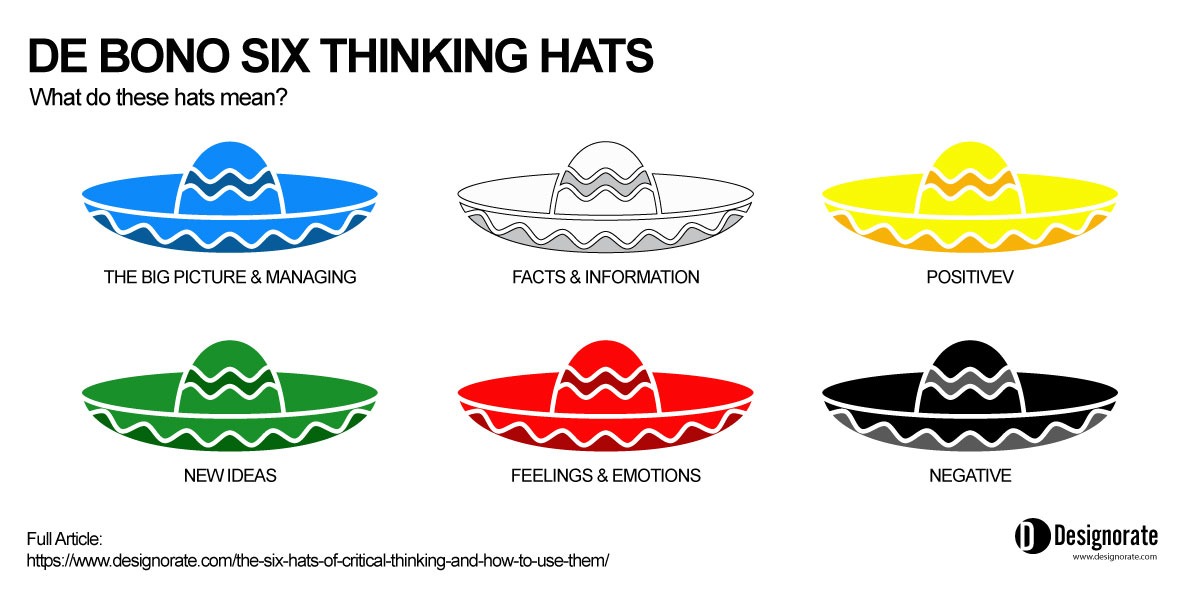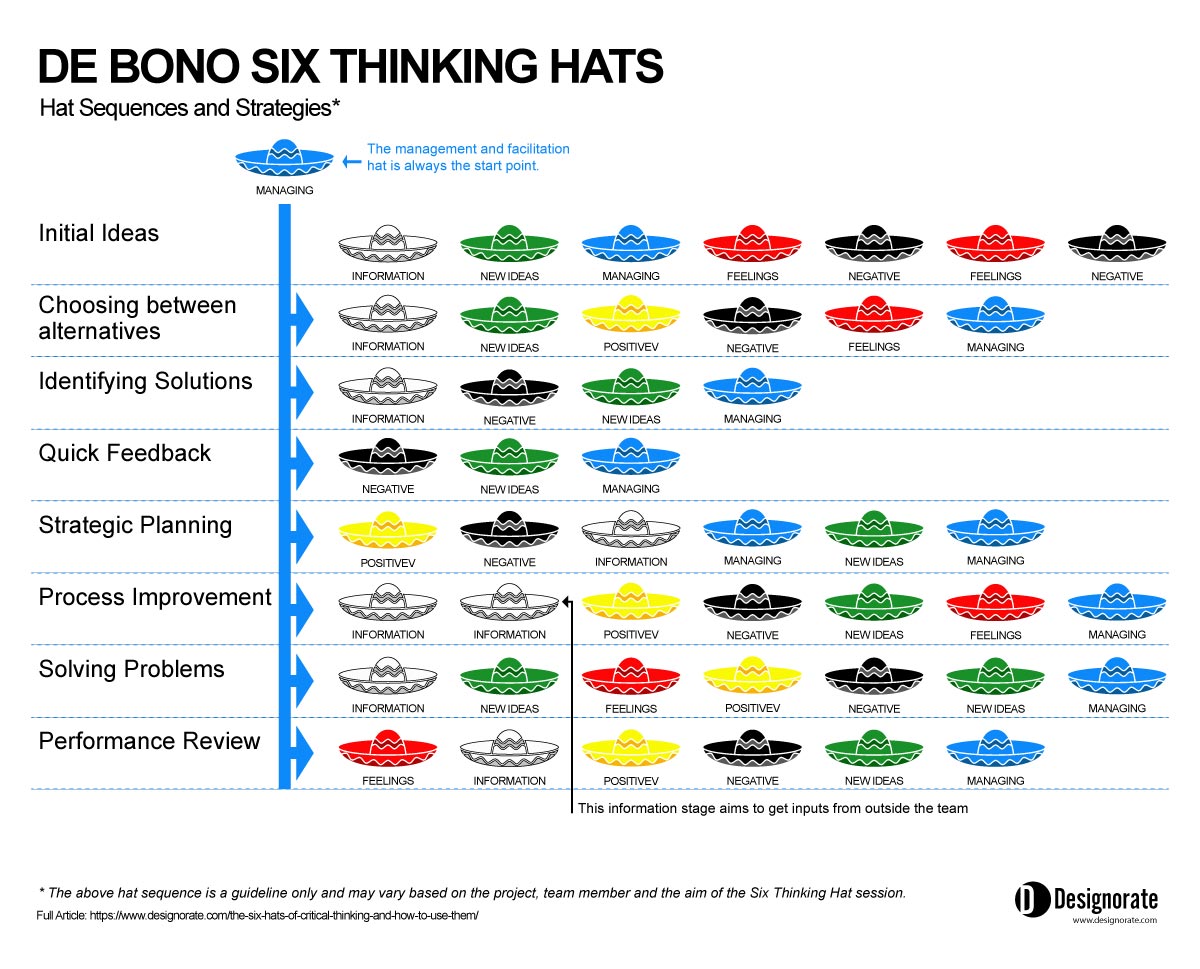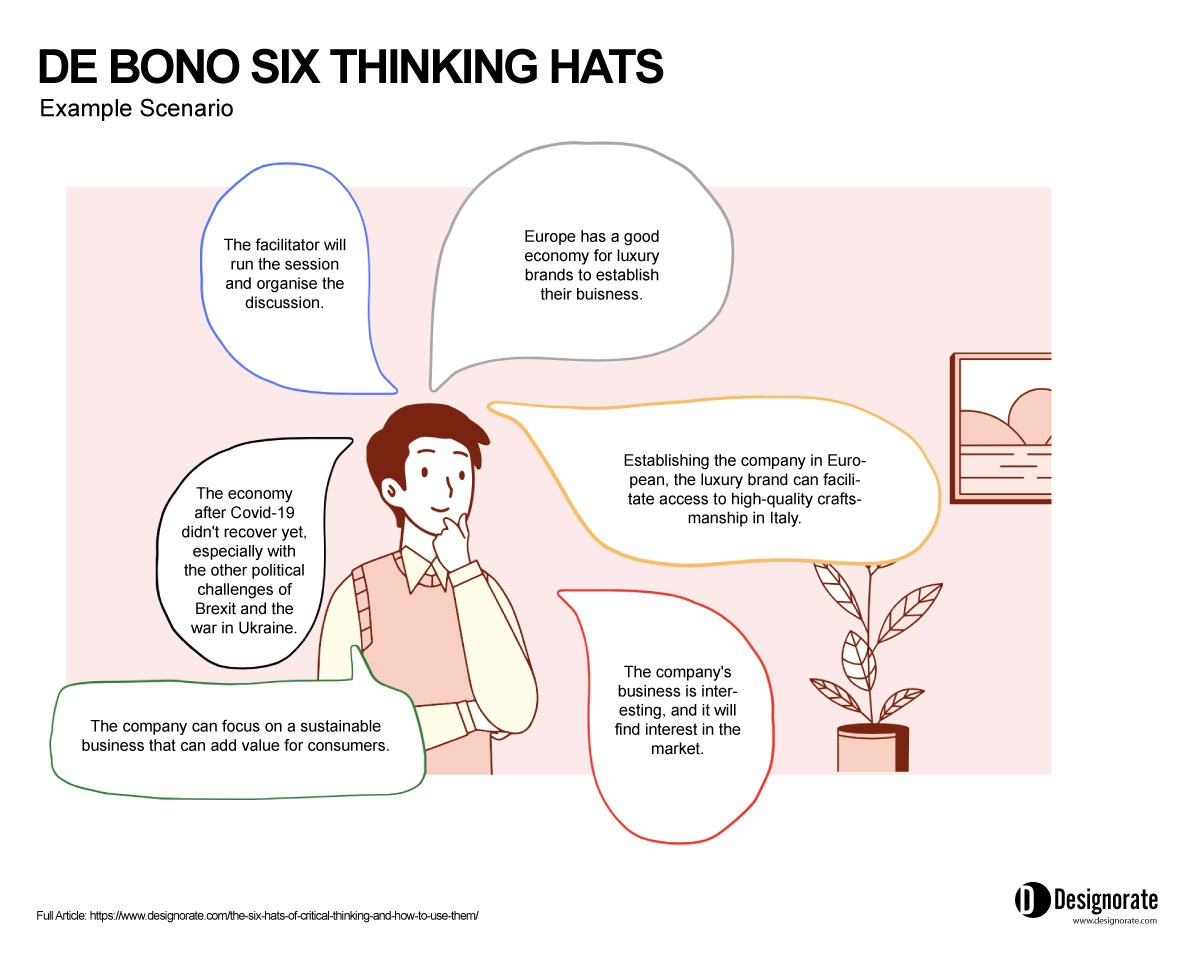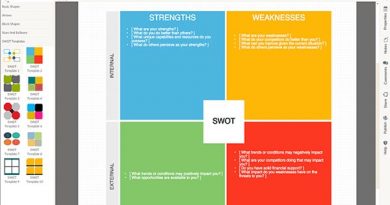What Are The Six Thinking Hats? And How to Use Them?
Design thinking and group discussion are highly complex processes in which thoughts are shared, ideas bubble up, and others are buried. De Bono’s Six Thinking Hats technique provides a systematic solution to sharing and improving ideas by eliminating idea-destructive elements during brainstorming meetings.
Our human thinking can be unstructured and reinforced, so different types of thoughts can drive individuals and design thinking groups to think irrational and biased toward specific ideas, which contradicts the aim of the design thinking process. The six hats thinking hats introduced a technique to discuss topics based on a particular order rather than a chaotic discussion. While the six thinking hats method does not follow ordinary human thinking, it can be used during a specific critical thinking session to achieve specific targets such as solving problems, discussing argument, in-depth analysis for planning process and running the creative thinking process.
Read also:
- A Guide to the SCAMPER Technique for Creative Thinking
- The Double Diamond Design Thinking Process and How to Use it
- How to Apply Paul-Elder Critical Thinking Framework
What Are the Six Thinking Hats?
In his book, Lateral Thinking for Management, De Bono introduced a directional sequence used in the brainstorming process. The Six Hats thinking method is based on a metaphorical six hats representing different human thinking types. The team uses these hats to address situations based on sequenced thoughts rather than chaotic discussions. The Six Hats thinking can be used during critical thinking sessions to achieve specific targets such as solving problems, discussing an argument, planning in-depth, and analysing the creative thinking process. Although the method has been introduced for companies to improve the return of investment (ROI), it can successfully be applied to school students in design thinking in education. During the last four years, I’ve adopted the Six Thinking Hats while teaching the design process for my master level students to organise their thoughts while designing their brand business. I will use this example later when we cover the practical application of the tool.

The Six Thinking Hats
Solving problems using the six thinking hats model requires looking at different thinking perspectives. Each perspective is represented with a hat colour. At the end of the discussion session, stakeholders should better understand the problem from other approaches to reach creative and innovative solutions. During each critical thinking discussion meeting, the facilitator determines which hat should be worn in a specific part of the discussion as follows:
White hat
This hat represents the facts and information about the problem of the argument. During this part, the stockholders only share information about the issue and take notes. No further development in the thinking process should be done. Questions in this part can be “what is the available information?” and “what are the facts we have?”
Yellow hat
In contrast to the black hat, the yellow hat supposes to reflect the sun or an optimistic attitude. The stakeholders think from an optimistic point of view about the problem or suggestion. It helps to spotlight the advantages and benefits of the recommendations. During this, the questions are “what are the advantages of applying the solution?” and “why do you think it is workable?”
Black hat
Wearing the black hat drives attendees to think about the problem or suggestion cautiously and defensively. This part aims to identify the cons of the proposal and the disadvantages, and why the idea may not work based on logical reasons.
Focusing on the warnings, risks or cautions helps the stakeholders to isolate the reasoning and think of the solutions in the yellow one. During this discussion, the question that can be asked is “what are the risks?” and “why is the suggestion not working?”
Red hat
The emotions hat presents the stakeholders’ feelings about the problem and their gut reactions. Using this hat is to understand the different emotional responses such as love, hate, like and dislike. The red hat does not aim to understand the reason behind these feelings. We can ask questions like “what do you feel about the suggestion?” and “what is your gut reaction?”
Green hat
This hat represents the creative thinking part of the discussion. During the critical thinking discussion, this hat fuels the stakeholders’ thinking to innovate a creative thinking solution for the problems or look to the suggestions from a creative perspective. Innovative tools can drive creativity during the conversations, such as the Lego Serious Play and brainstorming techniques.
Blue hat
This hat is the process control plan where the meeting leaders manage difficulties during the discussions. It makes sure that the guidelines of the six thinking hat technique is applied. This hat can be used to drive the thinking process to better routes. For example, the facilitators can direct the discussion to the green hat route if there are no ideas.
I believe the hat’s sequence and which set of hats to use during the commenting or evaluation session is not fixed, yet it is determined by the type of the project, the team, and the session’s aim. Figure 2 below shows how the order of hats changes from one aim to another.

How to Apply the Six Thinking Hats Technique?
The six thinking hats technique has many applications for exploring ideas or evaluating them. While teaching Luxury Brand Management to my postgraduate students at Northumbria University in London, they worked to design their luxury business using many design and business tools. We applied the six thinking hats to build organised feedback from different perspectives.

The following brief example presents the application of the six thinking hats in providing feedback on a proposed luxury brand:
The student group presents their luxury business, including the different tools used to develop their brand, such as the business model canvas, SWOT, persona and creative brief.
The blue hat is owned by the facilitator who runs the session in these classes, usually the class tutor: the facilitator organisation the presentation and moves from one hat to another. The team starts with the white hat answering the question, what do we know about the brand and the market. For example, The current information about the luxury business in Europe and its impact on the company.
Then, the team puts the yellow hat representing the positive views about the brand. The facilitator can ask questions such as “what are the advantages of the current business setup?” and “what are the positive impact on the brand?” In this practice, establishing a European-based luxury brand can facilitate access to high-quality craftsmanship in Italy.
Then the team wears the black hat to discuss the fears or cautions, such as the risks and the challenging points. For instance, the economy after Covid-19 didn’t recover yet, especially with the other political challenges of Brexit and the war in Ukraine. The red hat reflects the emotional feelings toward the luxury business. For example, The company’s business is interesting, and it will find interest in the market.
The final hat is the green one, representing new ideas and innovation. The team explores what new ideas can be added to the business. For example, the company can focus on a sustainable business that can add value for consumers. At the end of the discussion, the facilitator (blue hat) summarises the conversation and the outcome of the meeting.
The six thinking hats method provides a parallel thinking model to get the most out of critical thinking discussions. By organising the thinking process using the metaphor of the six hats, stakeholders can ensure that the thinking process covers the topic from different perspectives and points of view. This organised thinking approach occurs quickly during the discussion to reach the best possible output of the design thinking process. While the six thinking hats technique is discussed separately from the design thinking process, both work closely toward building creative solutions and innovative approaches.
Bibliography:
- De Bono, E. (2017). Six Thinking Hats: The multi-million bestselling guide to running better meetings and making faster decisions. Penguin uk.
- Kivunja, C. (2015). Using de Bono’s six thinking hats model to teach critical thinking and problem solving skills essential for success in the 21st century economy. Creative Education, 6(03), 380.
- Göçmen, Ö., & Coşkun, H. (2019). The effects of the six thinking hats and speed on creativity in brainstorming. Thinking Skills and Creativity, 31, 284-295.
Summary:
It is one of the critical thinking tools introduced by De Bono. It allows you to discuss the problem from five perspectives in a parallel approach. It ensures organised discussion and considering the problem from these perspective.
Blue: It is the facilitator hat, and it is used to manage the discussion.
White: The information hat where we try to explore the different information about the topic.
Yellow: The positive hat lets the team focus on the positive side of the issue.
Red: The emotion hat lets the team share their feelings about the issue.
Black: This hat highlights the caution and the negative side of the situation.
Green: This is the creative hat where the team can share creative ideas about the situation.
Note: This article was first published on January 2015 and updated on May 2022.







This is very helpful, I definitely will include it in my Professional communications assignment but i need the publication date of this article.
It is helpful. The idea is brilliant. It could be applied individually or within a group to have a cohesive methodical brainstorming.
Dear Rana, thanks and glad you find the method useful. I use it with my students all the time. Thanks! Rafiq
This is so fantastic and may you continue to create such powerful content
Thanks!